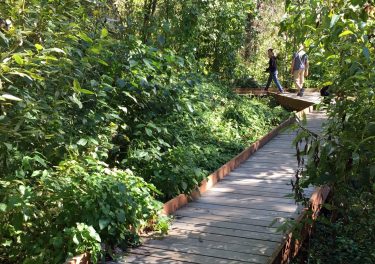What is the Husky experience? Well, that depends on who you ask.
 Anthony Martinez, School of Environmental and Forest Sciences
Anthony Martinez, School of Environmental and Forest Sciences
I grew up in Colorado in the 1990s and 2000s, when there was a huge pine beetle outbreak — they killed all the trees. My family and I would drive into the mountains and everything would be brown, and I thought, “Hey, I want to do something to fix that.”
I took wildland fire management with professor Ernesto Alvarado last year. Forest fires are a popular topic within forestry, but I didn’t have an interest until I took his course. Now I’m an undergraduate research assistant in his Wildland Fire Sciences Lab, and even joined him last summer to do LIDAR at the King Fire in Northern California. LIDAR is a cool tool that uses laser technology to create a 3D map of the forest to give us more accurate information much, much quicker — it’s the latest and greatest in our field.
I’m interested in sustainable forest management, and my research looks at how forest fuels change after post-fire salvage logging. Salvage logging is a contentious subject, and our aim is to add some objective data to the debate. If the effects of salvage logging on fuels can be quantified and predicted, forest managers can make more informed decisions on how to sustainably manage their forests after disturbances.
I joined the U.S. Navy right out of high school, providing patient care and working in purchasing as a hospital corpsman in Guantanamo Bay, Cuba for three-and-a-half of my five years in the service. The Navy instilled a lot of good traits in me — a strong work ethic, integrity, and a mindfulness and appreciation for financial stewardship. An education is a privilege, and it means a lot to me that donors have entrusted me with their resources so I can focus on my courses.
I came to Seattle for the University of Washington — it’s one of the only universities with a program like this. After graduation, I want to go to graduate school at the UW to get a master of forest resources, then work as a forest researcher before moving into forest policy.
Anthony is a student in the School of Environmental and Forest Sciences, and his work is supported by the School of Environmental and Forest Sciences Scholarship and the College of the Environment Scholarship. Learn more about supporting UW College of the Environment
 Tyler Valentine, Department of Earth and Space Sciences
Tyler Valentine, Department of Earth and Space Sciences
I asked for a chemistry set for my birthday every year until I turned 16. I never got one! I grew up in a lower-middle-class family, and the only science I really got to practice at home was cooking — cooking is chemistry. But then I took a physics class, and that got me going on the hard physical sciences. I started to teach myself about astronomy and astrophysics, got super interested in planetary science and space exploration, and now I’m obsessed.
I’m part of the Advanced Propulsion Lab, where we work on electric propulsion for cubesats, or small satellites. I’m also a member of the UW CubeSat team. We’re currently designing a small satellite that we’ll be sending up to space in 2017 — we’re testing a communication system and a plasma propulsion system, and my job is to predict when the satellite will pass over Seattle in orbit.
I’m a Washington NASA Space Grant scholar, and this year we’re launching an RSO called SPACE (Scholars Pursuing Academic Celestial Exploration), a community built around research and outreach opportunities to increase the number of minority students in earth and space sciences. We do rocketry showcases around the Pacific Northwest where kids can build their own model rockets and get a mini tour of the solar system — the goal is to encourage curiosity.
I’m really into planetary science and space exploration in general, but my main passion is asteroid mining. The idea is that you can go to an asteroid, latch on a spacecraft, and then extract a bunch of resources from it. My dream is to start my own asteroid mining company after pursuing a Ph.D. in space science and technology.
I transferred to the UW my freshman year with the help of scholarship support, which alleviates so much stress. I was working part-time while going to school full-time and participating in research, which meant I couldn’t fully devote my energy to my studies or my research. Now I can focus on what I really love to do.
Tyler is a student in the Department of Earth and Space Sciences, and his work is supported by the Washington NASA Space Grant Scholarship and the College of the Environment Scholarship. Learn more about supporting UW College of the Environment
Be Boundless — For Washington, For the World
The University of Washington is launching the public phase of its most ambitious philanthropic campaign in history, with a goal of raising $5 billion by the year 2020 for scholarships, unique programs and research opportunities for students — like those supporting Anthony, Tyler and other students across the UW. The campaign will also generate funds to recruit and retain world-class faculty, build and maintain buildings around campus to expand capacity and increase the lifespan of existing structures, and more.
The campaign focuses on four key priorities: transforming the student experience, expanding the impact of UW’s research, empowering possibility through innovation and driving the public good. The earliest phases of the campaign began in 2010, and the UW has already received more than $3 billion toward its goal.
More details about the launch of Be Boundless — For Washington, For the World are available via University of Washington News and Information.
Unleashing the Husky Experience »














